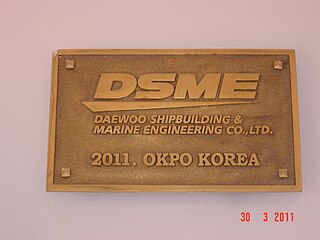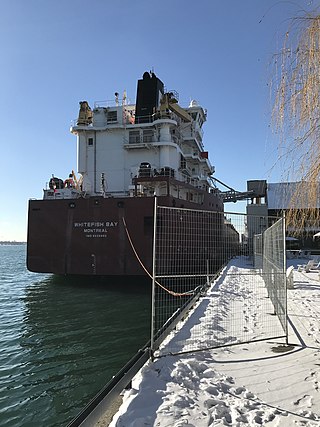
Panamax and New Panamax are terms for the size limits for ships travelling through the Panama Canal. The limits and requirements are published by the Panama Canal Authority (ACP) in a publication titled "Vessel Requirements". These requirements also describe topics like exceptional dry seasonal limits, propulsion, communications, and detailed ship design.

Canada Steamship Lines (CSL) is a shipping company with headquarters in Montreal, Quebec, Canada. The business has been operating for well over a century and a half.

A cargo ship or freighter is a merchant ship that carries cargo, goods, and materials from one port to another. Thousands of cargo carriers ply the world's seas and oceans each year, handling the bulk of international trade. Cargo ships are usually specially designed for the task, often being equipped with cranes and other mechanisms to load and unload, and come in all sizes. Today, they are almost always built of welded steel, and with some exceptions generally have a life expectancy of 25 to 30 years before being scrapped.

Vision of the Seas is a Vision-class cruise ship operated by Royal Caribbean International, the last of her class. Her maiden voyage was on May 2, 1998, following which she sailed for a year in Europe before being moved to other routes.

Chinamax is a standard of ship measurements that allow conforming ships to use various harbours when fully laden, the maximum size of such a ship being 24 m (79 ft) draft, 65 m (213 ft) beam and 360 m (1,180 ft) length overall. An example of ships of this size is the Valemax bulk carriers.

MS Ore Brasil, previously known as Vale Brasil, is a very large ore carrier owned by the Brazilian mining company Vale. She is the first of seven 400,000-ton very large ore carriers (VLOC) ordered by Vale from Daewoo Shipbuilding & Marine Engineering in South Korea and twelve from Jiangsu Rongsheng Heavy Industries in China, which are designed to carry iron ore from Brazil to Asia along the Cape route around South Africa. While close to the specifications of Chinamax, these ships are generally referred to as Valemax vessels by Vale. They are the largest bulk carriers ever built.

MV Vale Rio de Janeiro, owned by the Brazilian mining company Vale, is one of the world's largest very large ore carriers and a sister ship of Vale Brasil. Designed to carry iron ore from Brazil to Asia along the Cape route around South Africa, she is the second of seven 400,000-tonne very large ore carriers (VLOC) ordered by Vale from Daewoo Shipbuilding & Marine Engineering in South Korea and twelve from Jiangsu Rongsheng Heavy Industries in China. While close to the specifications of Chinamax, these ships are generally referred to as Valemax vessels by Vale.

Algoma Equinox is a lake freighter and lead ship of her class built for Algoma Central, a Canadian shipping company. The vessel was built to a new design by Nantong Mingde Heavy Industries at their shipyard in Tongzhou, China in 2013. The ship entered service in December 2013, operating in the Great Lakes and Saint Lawrence Seaway.

Baie St. Paul is a Trillium-class lake freighter operated on the Great Lakes by the Canada Steamship Lines (CSL). The ship entered service in 2012.

Atlantic Superior was a self-unloading bulk carrier owned and operated by Canada Steamship Lines (CSL). The ship was constructed in 1981, launching in 1982 and was the first self-unloading vessel designed, for ocean service, built for CSL. In 1997 the vessel was operated on behalf of National Gypsum Company as M.H. Baker III. In 2003, the ship returned to her former name Atlantic Superior. She was sold for scrap and broken up at Xinhui by Jiangmen Zhong Xin Shipbreaking in 2015.

Algolake was a self-unloading bulk carrier owned and operated by Algoma Central. The ship entered service in 1977 on the Saint Lawrence Seaway. In 1994, the ship ran aground in the St. Lawrence River off Quebec. The ship was laid up for scrapping in 2018, renamed Gola and was later scrapped in Aliağa, Turkey.

Thunder Bay is a Trillium-class lake freighter cargo vessel, built and launched in China in 2013. The ship is owned, and operated on the Great Lakes, by the Canada Steamship Lines (CSL). Like her three sister ships in CSL's Trillium class, Baie St. Paul, Baie Comeau, and Whitefish Bay, the vessel is a self-unloading bulk carrier, with a conveyor belt on a long boom that can be deployed over port or starboard sides.

Baie Comeau is the fourth and last self-unloading lake freighter in Canada Steamship Lines (CSL) Trillium class. Like her sister ships, Baie St. Paul, Thunder Bay, and Whitefish Bay she was built in China, being launched in 2012 and entered service in 2013.
Nunavik is an icebreaking bulk carrier owned and operated by the Canadian shipping company Fednav. She is used to transport copper and nickel from the Nunavik Nickel Project, making 7–8 round trips per year.

Whitefish Bay is a self-unloading lake freighter that entered service with Canada Steamship Lines (CSL) in 2013. Built in China, the vessel is the third of CSL's Trillium-class ships. Her sister ships are Baie Comeau, Baie St. Paul and Thunder Bay. Whitefish Bay is used primarily to transport goods on the North American Great Lakes and the St. Lawrence Seaway.

Pineglen was a bulk carrier owned and operated by Canada Steamship Lines. She was built at the Collingwood Shipyards, in Collingwood, Ontario in 1985, to a single superstructure lake freighter design. Initially named Paterson, the vessel was sold to Canada Steamship Lines in 2002 and renamed. Unlike more modern lake freighters she was built to a "straight-deck" design – i.e. she was not equipped with a self-unloading boom. The vessel was sold for scrap in 2017.

CSL Tadoussac is a lake freighter currently operated by Canada Steamship Lines (CSL) on the Great Lakes. She was launched in 1969. Initially named Tadoussac, following her refit in 2001, she was renamed CSL Tadoussac She was the last freighter built for CSL in the traditional two superstructure design, which puts her bridge up in the ship's bow. The vessel primarily transports iron ore and coal.
Nordic Odin is a panamax bulk carrier owned by Nordic Bulk Carriers. She was built by Oshima Shipbuilding of Saikai, Japan. She was delivered on February 13, 2015. The operation and management of the vessel is contracted out to Unicom Management of Cyprus. Her gross tonnage is 41,071; her deadweight tonnage is 76,180 tonnes.

The Trillium class is a series of freighters owned by Canada Steamship Lines (CSL). The class is divided into three subclasses; the self-discharging lake freighters, the lake bulk carriers, and the Panamax self-discharging bulk carriers. Initially a nine-ship building program, six are operated by Canada Steamship Lines for use on the Great Lakes, while three are operated by CSL Americas for international trade. Two more ships were acquired later for use by CSL Americas.
The Equinox class is a series of related bulk carriers operated by Canadian shipping company Algoma Central for service on the Great Lakes. Two variants of the class have been ordered, totaling twelve ships.
















